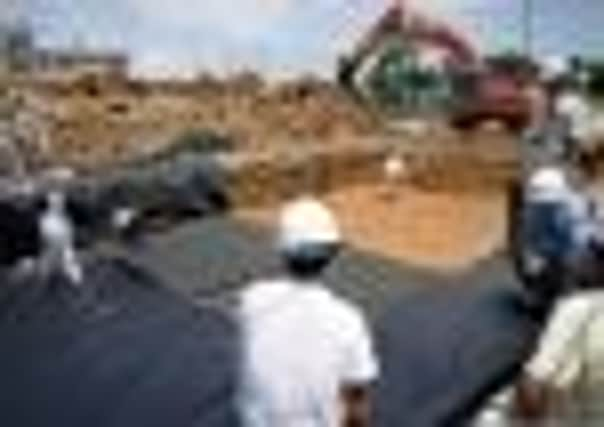Radioactive soil challenge for Japan


Six months after the 11 March earthquake and tsunami triggered reactor meltdowns, explosions and radiation leaks at the Fukushima Daiichi nuclear power plant on Japan’s north-east coast, the scale of the clean-up is only now becoming clear.
Contaminated zones where radiation levels need to be brought down could top 930 square miles, sprawling over Fukushima and four nearby prefectures, the ministry said in a report yesterday. Tokyo Metropolitan prefecture has a total area of 840 square miles.
Advertisement
Hide AdAdvertisement
Hide AdThe environment ministry has requested an additional 450 billion yen in a third extra budget for the year to next March that the government aims to submit to parliament in October.
The government has so far raised 220bn yen to be used for decontamination work, but some experts say the clean-up bill could reach trillions of yen.
If a two-inch layer of surface soil, likely to contain radioactive cesium, is scraped off affected areas, grass and fallen leaves are removed from forests, and dirt and leaves are removed from gutters, it would amount to nearly 29 million cubic metres of radioactive waste, the document showed.
This would be enough to fill 23 football stadiums with a capacity of 55,000 spectators, and the government must decide where to temporarily store such waste and how to dispose of it permanently.
Japan has banned people from entering within a 12-mile radius of the plant, which is located about 150 miles north-east of Tokyo and owned by Tokyo Electric Power. Some 80,000 people were forced to evacuate after the disaster.
The government aims to halve radiation over two years in places contaminated by the crisis, relying on both the natural drop in radiation as time passes and human efforts.
The ministry’s estimate assumes that clean-up efforts should be mainly in areas where people could be exposed to radiation of five millisieverts or more annually, excluding exposure from natural sources.
The unit sievert quantifies the amount of radiation absorbed by human tissue, and a millisievert is a thousandth of a sievert.
Advertisement
Hide AdAdvertisement
Hide AdMeanwhile, all three damaged reactors at Fukushima are below the boiling point, paving the way to bring them to a state of cold shutdown by the end of the year, Tokyo Electric Power declared yesterday.
After the natural disaster in March knocked out cooling systems and caused meltdowns of nuclear fuel rods at three of the plant’s six reactors, the company has been trying to cool them and bring temperatures below the boiling point.
Temperatures at two of the three affected reactors had already dropped below 100C in July and early September, leaving one reactor above boiling point. But temperatures at the last of the three reactors fell to 99.4C yesterday, according to company spokesman Takeo Iwamoto.
“The temperature has been moving up and down, but it is on a steady decline,” Iwamoto said. “We have cleared the temperature issue and taken a step forward towards achieving cold shutdown by the end of this year.”
Technically, a cold shutdown occurs when water used to cool nuclear fuel rods remains steadily below 100C, preventing the fuel from reheating.
But Tokyo Electric Power has said it will not declare a cold shutdown until other criteria are met, such as further reducing the amount of radiation being emitted from the plant. Achieving a cold shutdown is a precondition for the return of residents who were forced to evacuate areas near the plant.